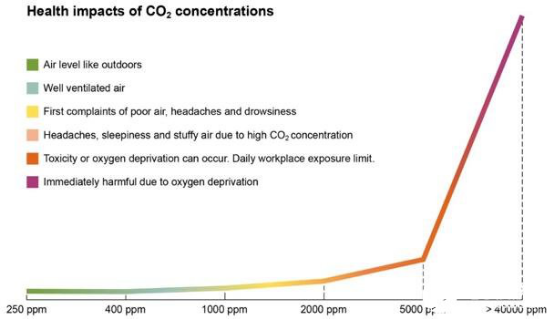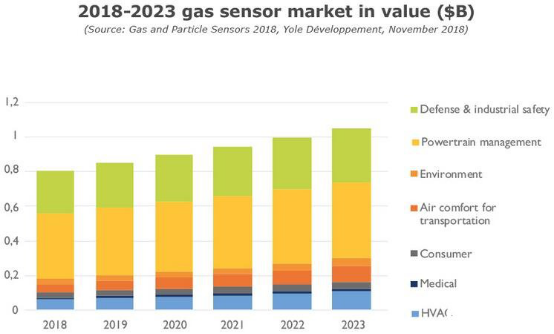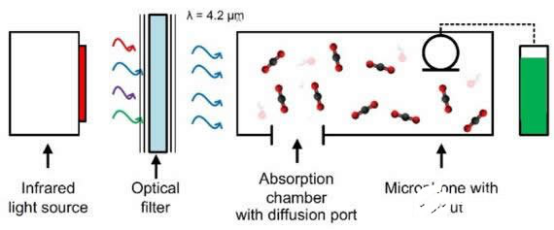Can MEMS gas sensors meet the special needs of various applications?
According to Mymes Consulting, CO2 (carbon dioxide) concentration is a key indicator of indoor air quality. Good air quality can make the people in them more energetic and more productive. Excessive CO2 concentration means poor indoor air quality, which is often caused by insufficient air conditioning and air recirculation. This condition can lead to well-documented health problems such as Sick Building Syndrome (SBS). Fine dust, mold, pollen, bacteria, and even other indoor toxins such as asbestos can also affect health.
CO2 limits prevent disease
Over the years, the concentration of greenhouse gases and CO2 in the environment has gradually increased due to human activities; today the value in the environment is slightly higher than 400 ppm (0.04%), which represents healthy fresh air. Indoors, CO2 concentrations of up to 1000 ppm (0.1%) are still considered acceptable, and this can be achieved with a good supply of fresh air. From a scientific point of view, CO2 concentration values are critical to health, as higher CO2 concentrations can have long-term negative effects on the human body.

Health effects of high CO2 concentrations
Even if the CO2 concentration is in the range of 1000 ppm (0.1%) to 2000 ppm (0.2%), the difference in air quality is obvious, and people will feel tired in such an environment. If CO2 levels continue to rise, people will feel stuffy, headaches, drowsiness, decreased concentration, and increased heart rate. Therefore, the World Health Organization recommends that indoor CO2 concentration be controlled to within 1000 ppm (0.1%) as much as possible. The US Environmental Protection Agency (EPA) clearly recommends that outdoor air circulation be used to improve indoor air quality. HVAC can be used to integrate heating, ventilation, and air conditioning.
CO2 sensors are essential in many applications
Considering the needs of a large number of applications, it is not surprising that market analysts expect the annual growth rate of the CO2 sensor market to reach double digits. According to the "Gas and Particulate Matter Sensor-2018 Edition" report released by Yole, the gas sensor market size will reach $ 1 billion by 2022. CO2 sensors can be used to monitor indoor air to ensure better ventilation in homes, schools, offices, and commercial buildings, thereby increasing people's attention and productivity. Smaller sensors are also suitable for the field of life and corresponding Internet of Things (IoT) devices such as digital assistants, smoke detectors, routers, air purifiers, and air conditioning systems, and can even be installed in laptops or displays.

Gas Sensor Market Scale from 2018 to 2023
Pattern recognition can be used to determine the number of people in a room and the level of people's daily activities. This information can provide better air-conditioning decisions for smart buildings. In HVAC systems, CO2 sensors help them reduce power consumption by up to 50%, which means energy savings of 20% to 30% for the entire building. This is because in ordinary systems, the air circulation is a constant fresh air input (for example, during working hours) in a timer mode; while management based on real CO2 measurement will adjust the fresh air supply according to the actual situation of the room. Therefore, the daily working cycle of the HVAC system is greatly shortened, and the energy saving effect is obvious.
In fact, there are many other applications of CO2 sensors, such as vehicle CO2 monitoring, which can adjust the driving position or the air quality in the entire vehicle. In agriculture, CO2 sensors can be used to control the CO2 concentration in the greenhouse to achieve higher yields and save costs. The CO2 sensor can also be used in medical applications such as a CO2 detector (capnometry); the CO2 detector is a method for measuring the CO2 content of a patient's exhalation in real time, and is particularly effective in the field of anesthesia.
Industrial cases include detecting CO2 leaks near CO2 sources such as dry ice reservoirs, storage tanks, and underground sources. Smart cities can also link CO2 emission sources to vehicle density for traffic management.
CO2 sensor technology today
At present, non-dispersive infrared (NDIR) sensors are widely used, especially in the field of intelligent buildings. However, because NDIR sensors are relatively large and expensive, they can only be used in limited areas. This sensor consists of an infrared light source, a sampling chamber, a filter, and a reference and absorption infrared detector, which can provide true and accurate CO2 measurement. However, except for purely aesthetic reasons, NDIR sensors are not suitable for installation in mobile devices, thermostats, and other smart home components in life. The main reasons are the higher cost and lower integration capabilities due to their external dimensions.
There is currently no similar solution on the market-both true and accurate CO2 measurement and cost-effectiveness. Although so-called eCO2 sensors can be used to detect various types of indoor pollutants, they are not a good substitute for NDIR sensors. The eCO2 sensor cannot complete the actual measurement. It uses an algorithm to calculate the equivalent CO2 value. The calculation assumes that the CO2 in the area is mainly generated by the personnel present. Therefore, eCO2 only provides estimates based on many assumptions. And the adjustment of indoor air quality based on this eCO2 value is only done based on potentially inaccurate information.
This situation may cause the air conditioning system to consume unnecessary energy, or it may not be able to ventilate properly when air conditioning is required. As a result, it is likely that the air quality cannot be effectively improved, and users will lose confidence in using this eCO2 sensor product.
MEMS gas sensor based on photoacoustic spectroscopy
Infineon successfully developed a new CO2 sensor based on photoacoustic spectroscopy (PAS) based on its MEMS microphone design experience and experimental process. PAS is a physical method that is suitable for detecting gas components in mixtures, such as CO2 concentration in indoor air.

Schematic of CO2 sensor based on photoacoustic spectroscopy
Photoacoustic spectroscopy is based on the fact that gas molecules only absorb light of a specific wavelength, and CO2 usually only absorbs light of a wavelength of 4.2 µm. An infrared light source with a filter provides energy to the gas quickly and continuously with pulses of light of precise wavelength. This results in rapid heating and cooling of the gas sample, which in turn results in thermal expansion and contraction. The resulting sound can be recorded and evaluated using a microphone and used to calculate the CO2 content of the gas. The higher the CO2 concentration, the stronger the acoustic signal. Compared with NDIR-CO2 sensors, the use of highly sensitive MEMS microphones as detectors can achieve significant miniaturization.
If you want to know more, our website has product specifications for the MEMS gas sensors, you can go to ALLICDATA ELECTRONICS LIMITED to get more information

